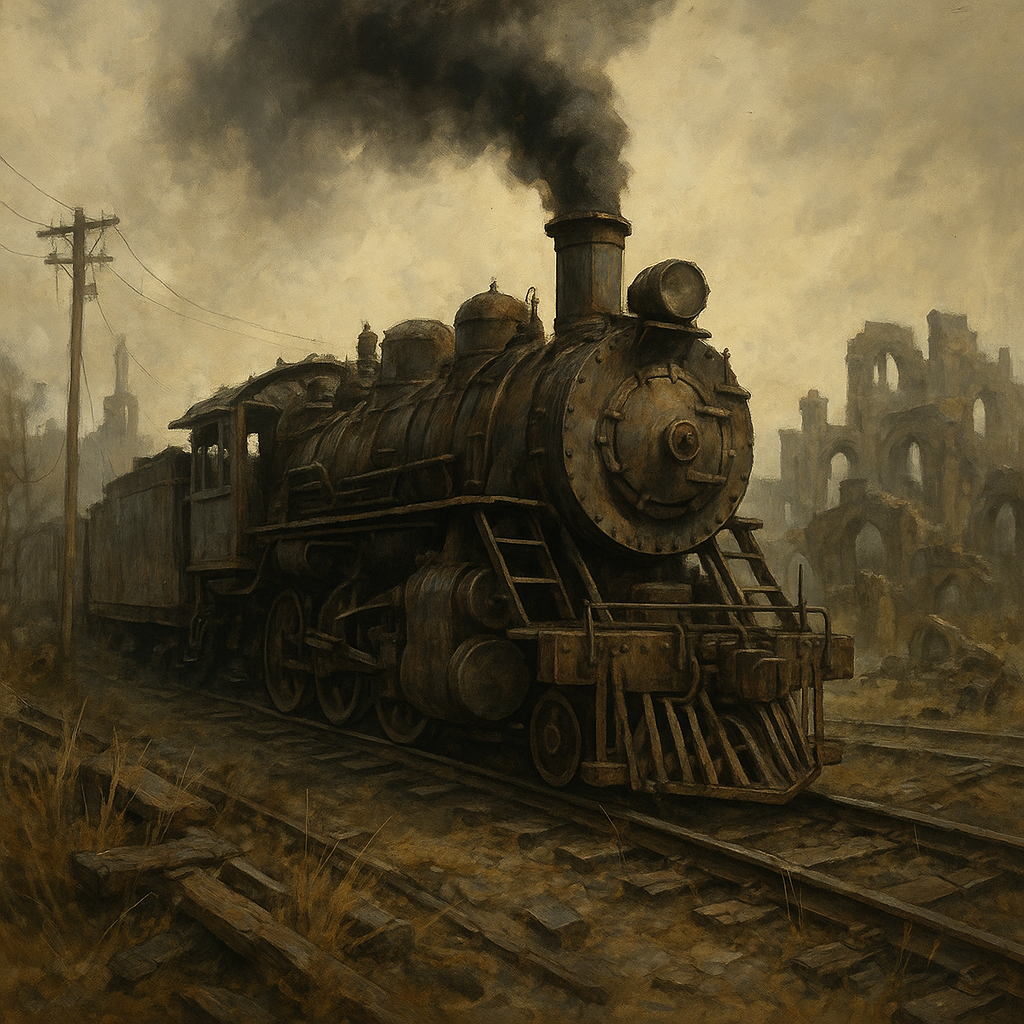Locomotives
"A train is a corpse that refuses to rest, patched, welded, and forced to run long after its time."
Once the pride of industrial ambition, the locomotive was a roaring titan of steel and steam, hauling civilization across vast distances with speed and strength that redefined trade, travel, and military power. Trains carved the bones of empire into the land, threading coasts to mountains and mines to cities. But that age of iron arteries has long since collapsed. The Great Schism made sure of that. What remains now are a cursed thirteen, grim survivors of long-dead ancient days, creaking down rusted rails like ghosts bound to purpose. Kept alive by blacksmiths masquerading as engineers, cannibalized by necessity, and prayed over like relics, these trains do not run so much as endure like the rest of us. No attempt to restore their production has succeeded since the Schism came to a close; After almost five-centuries of trying through catastrophic failure and subterfuge. No new engines will come. No new lines will be laid. They are the final breath of a forgotten god of motion, and one day, when the last wheel rusts and freezes, that breath will fall silent.
Utility
In its prime, the locomotive served to connect the kingdom, moving food, timber, weapons, and people with unmatched speed. Now, it is used only when the stakes outweigh the risk. A working train may be called upon to:
- Move critical cargo between fortress-cities.
- Evacuate whole towns from environmental collapse.
- Haul salvaged relics or unstable magickal materials.
- Provide backup artillery on mobile gun-cars.
Manufacturing
No new locomotives can be built. The factories that once forged them were either bombed during the Great Schism or stripped of anything usable in the decades of collapse that followed. Only a handful of engineers even understand the schematics well enough to try, and even they lack the tools. Efforts to restart production in Stargaze, Wardsea, and even Opulence have all failed. The necessary alloys are too rare, and the enchantments required to bind components are considered Class 2 Arcane Hazards under Coalition Law. In truth, every operational locomotive is not just a vehicle, it’s a museum piece bleeding from every bolt.
Social Impact
To most of Everwealth, the train is a myth, a roaring beast that eats coal and vomits thunder, spoken of in songs and soldiers’ stories. To those who maintain them, locomotives are holy terrors: sacred burdens, unholy relics, or loyal dogs too old to be put down. Trains once symbolized unity and dominance, the power to move armies across mountain passes or feed cities without waiting on caravans. Now, they symbolize what was lost, both functionally and spiritually. Communities near old rail lines speak of them like gods, fearful and reverent. Children leave offerings beside the tracks. Elders warn never to walk the rails at night, lest the Iron Ghost come screaming through the mist.
- Delnoth Ironsmoke - Dwarfish metallurgist from Deep Anchor who built the world's first steam engines.
- Etta Greaves - Human engineer of who standardized the passenger car format and track width still used by modern trains.
Access & Availability
Thirteen known functional locomotives remain in the entire kingdom, each jealously guarded by regional factions, noble houses, or merchant syndicates. None are in pristine condition. Each train is a collection of borrowed limbs and salvaged parts, often including components scavenged from wrecks, siege machines, or abandoned airship hulls. Access is strictly controlled. Railmasters determine if and when a locomotive moves. Use is limited to transporting vital cargo, military units, or messages too sensitive for couriers. Most common folk have never even seen one, let alone ridden.
Complexity
A functional locomotive in Everwealth is now considered a technological miracle, and an unpredictable one. Its operation requires:
- Combustion boiler (burning coal, pyrefuel, or treated bonewood).
- Pressure-regulated steam core.
- Arc-wired brake systems (if still intact).
- Forged iron wheels and track-welded undercarriage.
- Skilled operator and brakeman.
- Manual water-fed cooling tanks.
Discovery
Locomotive engineering was one of the defining technological achievements of The Lost Ages, first developed in the ore-thick valleys of the lands of Tarmahc, cradle of Humans and other folk, lost to the Schism. The original engines were powered by enchanted coal furnaces and reinforced boiler systems, hauling ore, grain, and soldiers alike across treacherous terrain. The earliest models, bulky, soot-belching juggernauts, were improved rapidly over several decades by many races who quickly adapted this technology, seeing its potential. Passenger lines followed, luxury cars rose in prominence, and for a time, Everwealth was knit together by steel veins and shrieking whistles that heralded progress. The peak of rail travel lasted only a generation before the Fall rendered it obsolete overnight.



Comments